
about ancient nomos
Ancient Nomos Art is a museum of galleries exhibiting ancient coins and ancient mint maps. The coin gallery displays the diverse art and history of hand-crafted ancient Greek, Roman, Byzantine, Persian and Medieval coinage. The ancient mints mapping gallery features Greek, Roman, Byzantine, Asia Minor and Medieval mint city regions and territories. Visitor's are welcome to explore, study and enjoy Ancient Nomos Art.

Medieval, France – 822 AD
Louis I 'le Pieux'
From Ancient Galleries

Obverse: Central cross pattée with four pellets, one in each quarter; beaded borders.
Reverse: Tetrasyle temple façade with cross on pediment; small cross between four columns.
LEGEND
Obv: +HLVDOVVICVS IMP, cross pattée with four pellets, one in each quarter. Rev: XPISTIANA RELIGIO, tetrasyle temple façade with double pediment and cross at spire; small cross between pelleted columns.
Louis the Pious, first son of the great Charlemagne of Francia, reigned as sole surviving heir and king over the same vast West Francia territory from 814 to 840 AD. While Louis is best known for unifying the empire, he was also able to achieve a single unified currency, an economic accomplishment not witnessed since Roman times. The above denier specimen represents the first successful, empire-wide Carolingian coin issue. A medieval coin that no other medieval ruler can claim, including his famous father. Known as the “temple” denier, the coin issue first began circulation throughout medieval Europe in 822 AD. The vast distribution of medieval mints included; south to the Spanish march, Frisia in the north to Brittany in the west, and finally to the borders of the Slav lands in the east. His temple issue is the third type of coin issue under his reign and is known as the third (class III) coinage. Some more commonly refer to the issue as the ‘Christiana Religio’ silver coinage, so named after its reverse legends proclaiming Christianity. The class III Louis issues differ from his previous coinage by their anonymity, achieved by the removal of the mints name from the coins reverse (see Louis I class II denier). The higher 1.70 gram weight is another characteristic feature of Louis the Pious’ new temple deniers. The obverse legend on the coin above begins at the small cross followed by the Latin abbreviation; HLVDOVVICVS IMP, signifying “Louis the Emperor” is king of Francia. A medium sized cross (pattée) is engraved in the coins center and features four small pellets in the fields of each quarter section of the cross. The coin reverse depicts a tétrastyle style Greek temple or church with a triangular pediment above. The triangular pediment contains a smaller pediment and is surmounted above with a small cross (croisette). The original temple denier issue by Louis the Pious lasted nearly 18 years under his reign, but his obverse cross and temple reverse imagery on the coins became a medieval standard and continued relatively unchanged for several more centuries. This iconic denier coin was emulated by successive French kings including; Louis the Germanic (840-876 AD), Louis II the Stammerer (877-879 AD) or Louis III of Saxony (876-882 AD), Louis III of France (879-882 AD), and Louis III the Blind (901-905 AD).
DOCUMENTATION
Value: Denier, class III. Metal: AR Silver. Weight: 1.72 grams. Mint: Unspecified (Venice?). Date: 822-840 AD.
Attribution: S. Coupland, Money and Coinage of Louis the Pious, Class III, plates II-IV; Depeyrot 1179 Series G: Venice; M&G 472; Ex. Dr. Bernhard Schulte collection of medieval coinage.
Legend, Documentation and Attribution
